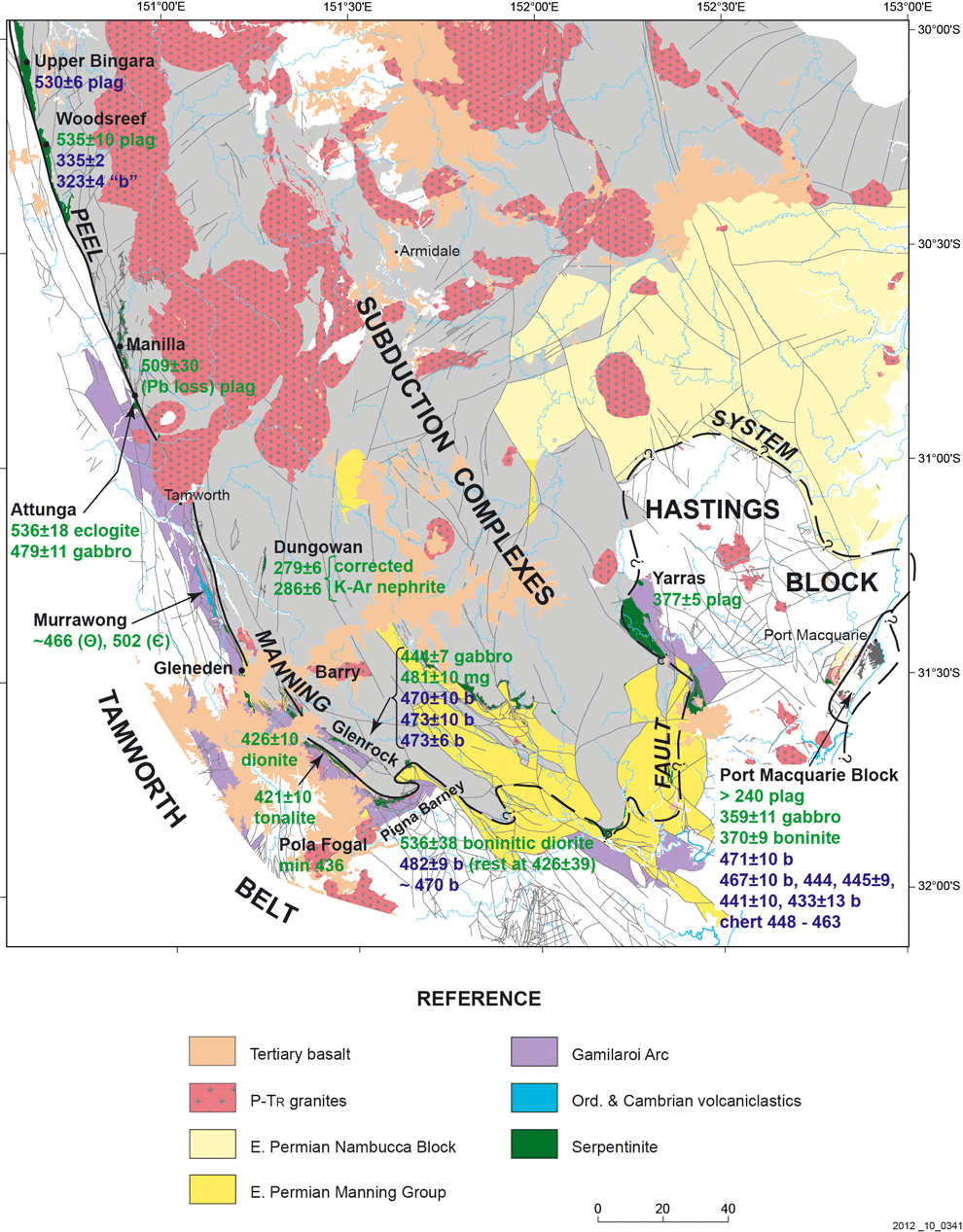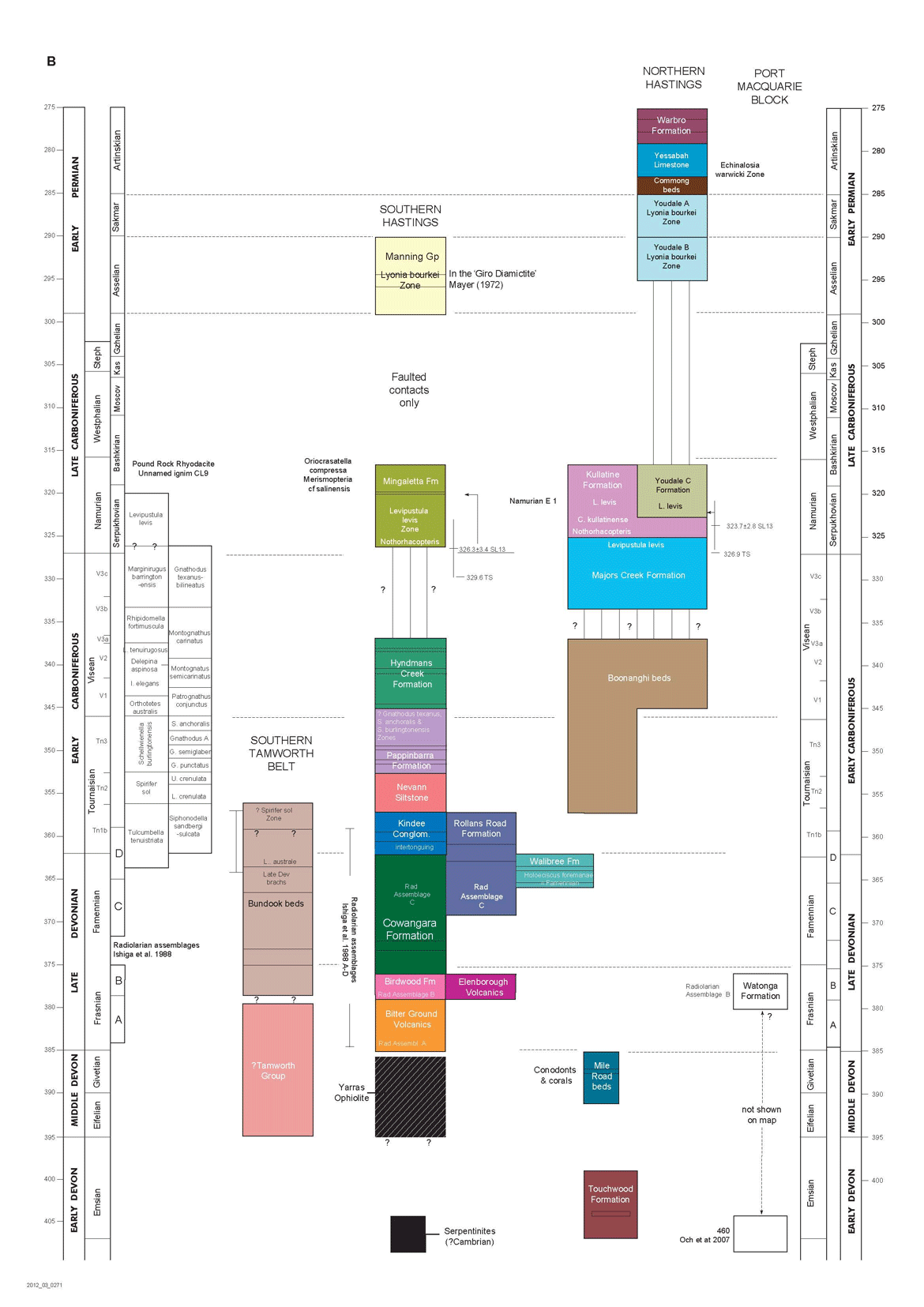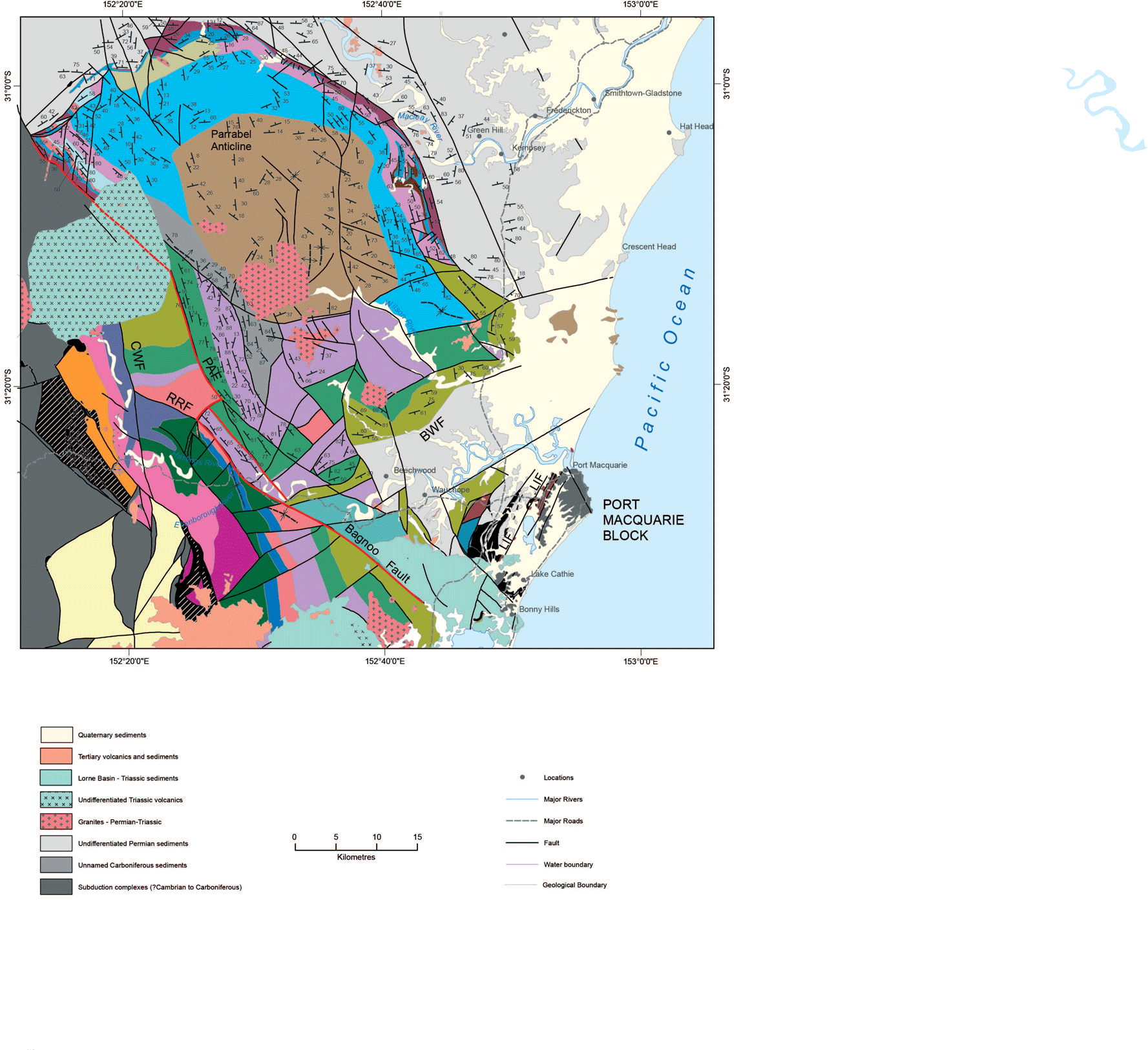Manning and Hastings Oroclines
On page 23 of our paper, we suggested that four separate datasets provide persuasive arguments for the presence of a southern Manning oroclinal hinge and a northern Hastings oroclinal hinge. These were: i) the fault boundary between subduction complex rocks and the forearc basin and its basement; ii) key Devonian-Carboniferous stratigraphic units in the forearc basin; iii) changes in outcrop shapes of the early Permian overlap assemblage above the boundary between forearc basin and subduction zone rocks; and iv) the curvature of arc proximal rocks and their inferred offshore location.
The curved fault boundary that separates subduction complex rocks from the basement to the forearc basin and the forearc basin itself is called the Peel-Manning Fault System. It is approximated by the presence of serpentinites. The clear image of serpentinites along the northern part of the Peel-Manning Fault System in the 1VD aeromagnetic image (our original figure 1c) compared to the more diffuse response in the southern part reflects covering by Early Permian strata in the south, the presence of which is shown in figure 3 of the original paper. Despite this, aeromagnetic anomalies inferred to represent serpentinite bodies can be tracked into the core of the Manning Orocline from the west, and into the western margin of the Hastings Block.
Lennox et al. (2013) argue that these belts of serpentinites cannot be used to outline the oroclines since they are not continuous and not all of the same age. We did not say that they were continuous. Indeed we cited Lennox and Offler (2009) who showed that although largely obscured by early Permian strata, discontinuous serpentinites wrap around the Hastings orocline. Discontinuous and indeed multiple belts of serpentinites are features of the Peel-Manning Fault System. Figure 1 (Figure 7 from Glen (2013)), shows this variable continuity, with splays north of Manilla, multiple belts of serpentinite at Glenrock (e.g. Offler and Williams 1987) and multiple belts extending north of Pigna Barney over a cross strike distance of ~35 km.
Figure 1. Map of the Peel-Manning Fault System

Map of the Peel-Manning Fault System showing variation in ages of igneous blocks in the serpentinite matrix melange. The figure also emphasises the variable distribution of serpentinite bodies along the fault system. From Glen (2013).
Glen and Roberts (2012 page 9) only mentioned in passing the Cambrian and younger ages of igneous blocks in the serpentinite matrix melange that was emplaced in the early Permian, and the Devonian age of the Yarras ophiolite on the western side of the Hastings Block prior as discussed in more detail by Glen (2013) and shown by our figure 1 (Figure 7 from Glen (2013)), and also stated by Lennox et al. (2013), the Peel-Manning Fault System encompasses serpentinites of a variety of ages. Igneous blocks vary in age from Cambrian to Devonian and the Permian age of serpentinisation at Dungowan (Lanphere and Hockley 1976) (Figure 1) has been applied to the whole belt. While Lennox et al. (2013) seem to regard this spread of ages as evidence against the orocline, Glen (2013) argued that they reflect the long-lived history of a complex structural zone (the Peel-Manning Fault System) that formed along the Gondwana-Pacific plate boundary and which can be tracked around the Manning and Hastings oroclines.
Location of hinge of Manning orocline in subduction complex rocks
Lennox et al. (2013) suggest that there is little evidence for the existence of the hinge of the Manning Orocline in subduction complex rocks. They suggest (page 3) that their figure 2 lies in the hinge of the expected orocline, but does "not define a steeply-plunging macroscopic fold as expected for an orocline (Figure 2)".
We specifically wrote on page 23 that: that our data do not extend into the subduction complex itself and that we had no data for or against the presence of the Manning orocline in those rocks. However, we did cite Cawood (1982) and Rosenbaum et al. (2012) who provided evidence for the presence of a hinge zone in those rocks. More recently, Li and Rosenbaum (2013) have presented compelling evidence for the existence of the hinge of the Manning Orocline within the subduction complex.
In support of the absence of the Manning orocline in the subduction complex, Lennox et al. (2013) present a new figure (figure 2 in their paper), which shows a fault-bounded packet of Devonian strata bounded by infaulted overlap assemblage Permian rocks on the west and east. They interpret this figure in terms of mesoscale folded Devonian rocks that do not support the presence of a north-closing macroscopic fold hinge. However, we interpret their data differently. We question the unfaulted contact between serpentinite and Devonian strata, and by using down-plunge viewing, we suggest that their figure 2 shows Devonian strata occupies a north-plunging, south-closing synformal hinge that has steep (65°) north and subvertical dips and subvertical limbs with dips both to the east and west. Moreover, this sole of this the hinge is occupied by serpentinite, suggesting a twofold history with subduction complex rocks thrust south over serpentinite in a D1 event and then the whole package folded around a north plunging synform in a D2 event.
Figure 2. Geological map

A. Enlargement of the northern part of Figure 5a of Glen and Roberts (2012), also showing representative dip and strike values, taken from compilation by Roberts (unpublished). Note large variations in dip values and dip directions in units around the Parrabel Anticline. Legend from Glen and Roberts (2012). B. Legend (Figure 5B of Glen and Roberts 2012)
Location of hinge of Manning orocline in forearc basin rocks
Lennox et al. (2013) argue that there is no evidence of the Manning orocline in forearc basin rocks because Devonian to Carboniferous sequences south and southeast of the Mt George area are disrupted by N-S, NNE, E-W and NW trending faults. They argue that "Bedding within the fault bounded blocks does not define an oroclinal structure, rather steeply dipping homoclinal sequences of varying orientation and uncommon N-S, NW and E-W trending, shallow plunging folds". This confirms what we wrote (page 23): that there is a lack of continuity of forearc basin rocks around the Manning orocline. We suggested (page 23) this reflects the strong D2 deformation in the hinge, where stratigraphy is broken up by a series of N to NNW-trending fault slices that fan around the hinge (Fig. 3). Figures 4 and 7 (Glen and Roberts, 2012) show that the continuity of bedding is progressively destroyed approaching the hinge of the Manning orocline from the west, with strata broken up by the increasingly strong D2 deformation. We said that it was the formation of N to NNW faults and D2 folds that interrupted a once-continuous sequence, replacing it by fault-bounded panels of different dips.
Trench-pointing vector
Lennox et al. (2013, page 4) doubt our suggestion that the vector pointing towards the plate boundary from forearc basin strata to subduction complex rocks rotates around the Hastings orocline, although they concede it rotates around the Manning orocline. They suggest that the Ordovician cherts documented at Port Macquarie (Och et al., 2007) are older than the Silurian-Carboniferous subduction complex rocks farther west, thus invalidating this argument. However, subduction complexes commonly contain units with a spread of geological ages. The Port Macquarie Block contains a whole series of geological units ranging in age from Ordovician to Triassic. Nutman et al. (2013) recently suggested that eclogite blocks in serpentinite, were Triassic rather than Cambrian or Ordovician as previously inferred, highlighting the fact that there is still much to learn about the ages of units in this block. Silurian (~427 Ma) tectonic activity in the block involving serpentinisation was documented by Och et al. (2010). The Watonga Formation in the Port Macquarie Block contains a range of lithologies and was previously dated as Late Silurian–Late Devonian based on the presence in cherts of the conodont Belodella spp. and the palaeosceniid radiolaria including Palaeorubus hastingensis, (Ishiga et al., 1987; Ishiga et al., 1988a, b). It is unclear whether the Middle–Late Ordovician age from chert (Och et al., 2007) applies to the whole formation, or whether there is a spread of ages from Ordovician to the Late Devonian or even younger.
